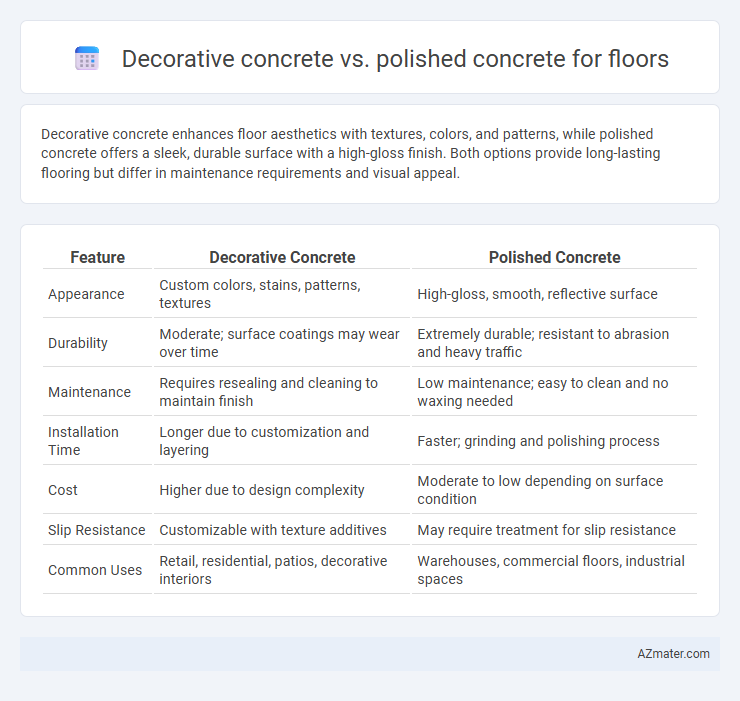Decorative concrete enhances floor aesthetics with textures, colors, and patterns, while polished concrete offers a sleek, durable surface with a high-gloss finish. Both options provide long-lasting flooring but differ in maintenance requirements and visual appeal.
Table of Comparison
| Feature | Decorative Concrete | Polished Concrete |
|---|---|---|
| Appearance | Custom colors, stains, patterns, textures | High-gloss, smooth, reflective surface |
| Durability | Moderate; surface coatings may wear over time | Extremely durable; resistant to abrasion and heavy traffic |
| Maintenance | Requires resealing and cleaning to maintain finish | Low maintenance; easy to clean and no waxing needed |
| Installation Time | Longer due to customization and layering | Faster; grinding and polishing process |
| Cost | Higher due to design complexity | Moderate to low depending on surface condition |
| Slip Resistance | Customizable with texture additives | May require treatment for slip resistance |
| Common Uses | Retail, residential, patios, decorative interiors | Warehouses, commercial floors, industrial spaces |
Introduction to Decorative and Polished Concrete Floors
Decorative concrete floors enhance spaces by incorporating color, texture, and patterns, offering a versatile and customizable flooring solution for residential and commercial applications. Polished concrete floors feature a mechanically ground surface with a high-gloss finish, providing durability, low maintenance, and improved light reflectivity in high-traffic areas. Both options deliver aesthetic appeal and functional benefits, with decorative concrete emphasizing artistic expression and polished concrete focusing on resilience and shine.
What is Decorative Concrete Flooring?
Decorative concrete flooring enhances surfaces using techniques like stamping, staining, or scoring to create visually appealing patterns and textures. It offers a versatile design palette with options such as color dyes, overlays, and finishes, allowing customization for both residential and commercial spaces. This flooring type combines durability with aesthetic appeal, making it ideal for transforming plain concrete into artistic and functional surfaces.
What is Polished Concrete Flooring?
Polished concrete flooring is a high-gloss, smooth surface created by mechanically grinding and polishing concrete slabs to expose aggregates and achieve a reflective finish. This flooring option is highly durable, low-maintenance, and resistant to stains and wear, making it ideal for commercial and residential spaces alike. Compared to decorative concrete, which often involves overlays, stains, or patterns, polished concrete emphasizes the natural beauty of the concrete itself through its sleek, modern appearance.
Aesthetic Differences: Styles and Customization
Decorative concrete offers a vast array of styles including stamped patterns, stains, dyes, and overlays, allowing for intricate designs and vibrant color customization that mimic natural stone, tile, or wood. Polished concrete emphasizes a sleek, smooth, and reflective finish by grinding and sealing the surface, showcasing the concrete's natural texture and aggregate with minimal color variations. The customization of decorative concrete is highly versatile for artistic and themed spaces, whereas polished concrete is favored for modern, minimalist aesthetics with subtle, elegant visual appeal.
Durability and Longevity Comparison
Decorative concrete offers a range of finishes and colors that enhance aesthetic appeal but may require periodic sealing to maintain durability over time. Polished concrete is highly durable and resistant to wear, offering exceptional longevity with minimal maintenance due to its dense, hardened surface. Both options provide strong flooring solutions, but polished concrete generally outperforms decorative concrete in terms of abrasion resistance and lifespan in high-traffic environments.
Maintenance Requirements for Both Flooring Types
Decorative concrete requires regular sealing every 2-3 years to maintain its stain resistance and vibrant appearance, along with routine cleaning using pH-neutral cleaners to prevent surface degradation. Polished concrete demands less intensive upkeep, relying on frequent dust mopping and occasional wet mopping with mild detergents to preserve its high-gloss finish and durability. Both flooring types benefit from protective mats in high-traffic areas to minimize abrasion and extend maintenance intervals.
Cost Analysis: Installation and Long-Term Expenses
Decorative concrete typically costs between $3 to $12 per square foot for installation, depending on patterns and color treatments, while polished concrete ranges from $4 to $15 per square foot, influenced by the desired gloss level and surface preparation. Long-term expenses for decorative concrete may include regular sealing and potential resurfacing every few years, whereas polished concrete requires less maintenance, mainly periodic cleaning and occasional re-polishing, making it more cost-effective over time. Evaluating total lifetime costs, polished concrete often delivers better value for high-traffic areas due to its durability and lower upkeep requirements.
Slip Resistance and Safety Features
Decorative concrete offers enhanced slip resistance through textured finishes, stamped patterns, and anti-slip additives, making it ideal for high-traffic areas requiring extra safety. Polished concrete, while sleek and low-maintenance, can become slippery when wet unless treated with non-slip coatings or sealers to improve traction. Prioritizing slip resistance, decorative concrete generally provides superior safety features compared to polished concrete in environments where slip hazards are a concern.
Ideal Spaces for Decorative vs Polished Concrete
Decorative concrete, with its versatility in colors, patterns, and textures, is ideal for residential living areas, retail spaces, and outdoor patios where aesthetic appeal and customization are prioritized. Polished concrete excels in commercial settings such as warehouses, showrooms, and office lobbies due to its durability, low maintenance, and reflective surface enhancing natural light. Both finishes provide practical and stylish flooring solutions but serve distinct environments based on functional requirements and design goals.
Choosing the Right Concrete Floor for Your Needs
Decorative concrete offers a wide range of design options including stains, stamps, and dyes, making it ideal for those seeking unique aesthetics and customization in flooring. Polished concrete provides a durable, low-maintenance surface with a sleek, reflective finish, perfect for high-traffic commercial or industrial spaces. Choosing between decorative and polished concrete depends on factors like desired appearance, durability requirements, maintenance levels, and budget considerations.

Infographic: Decorative concrete vs Polished concrete for Floor
 azmater.com
azmater.com